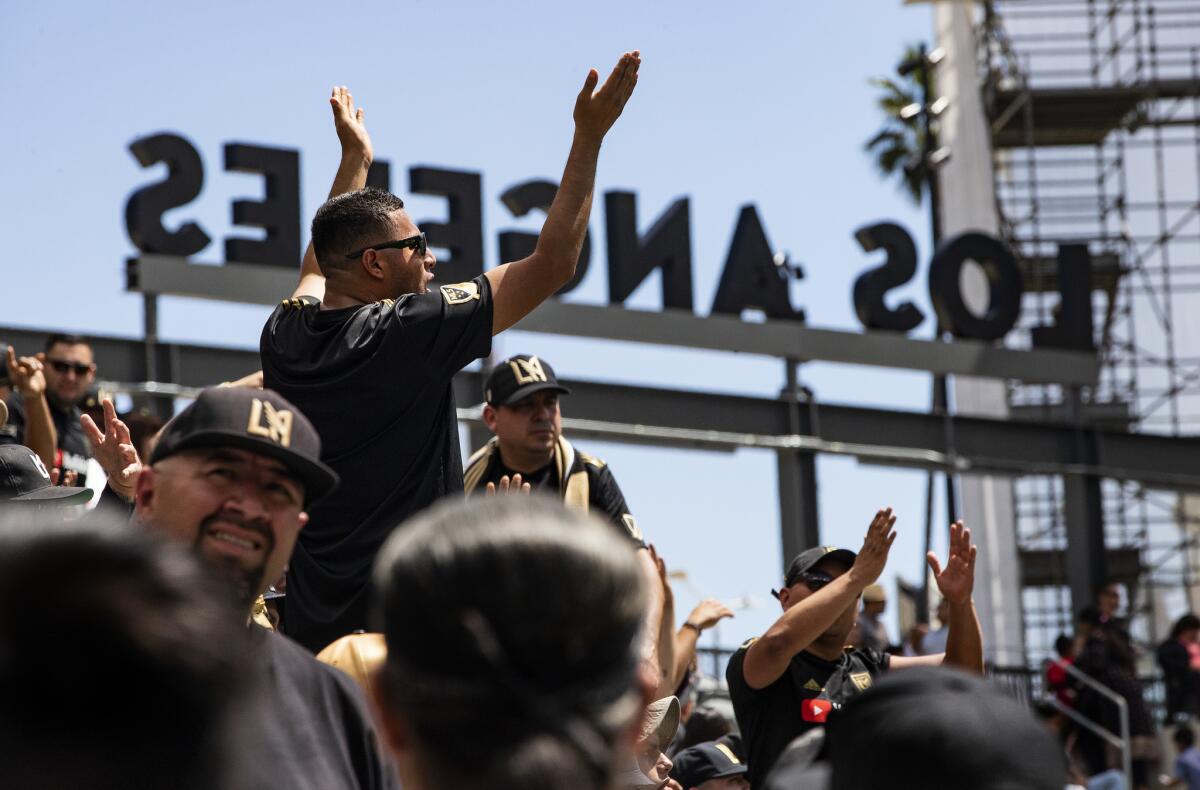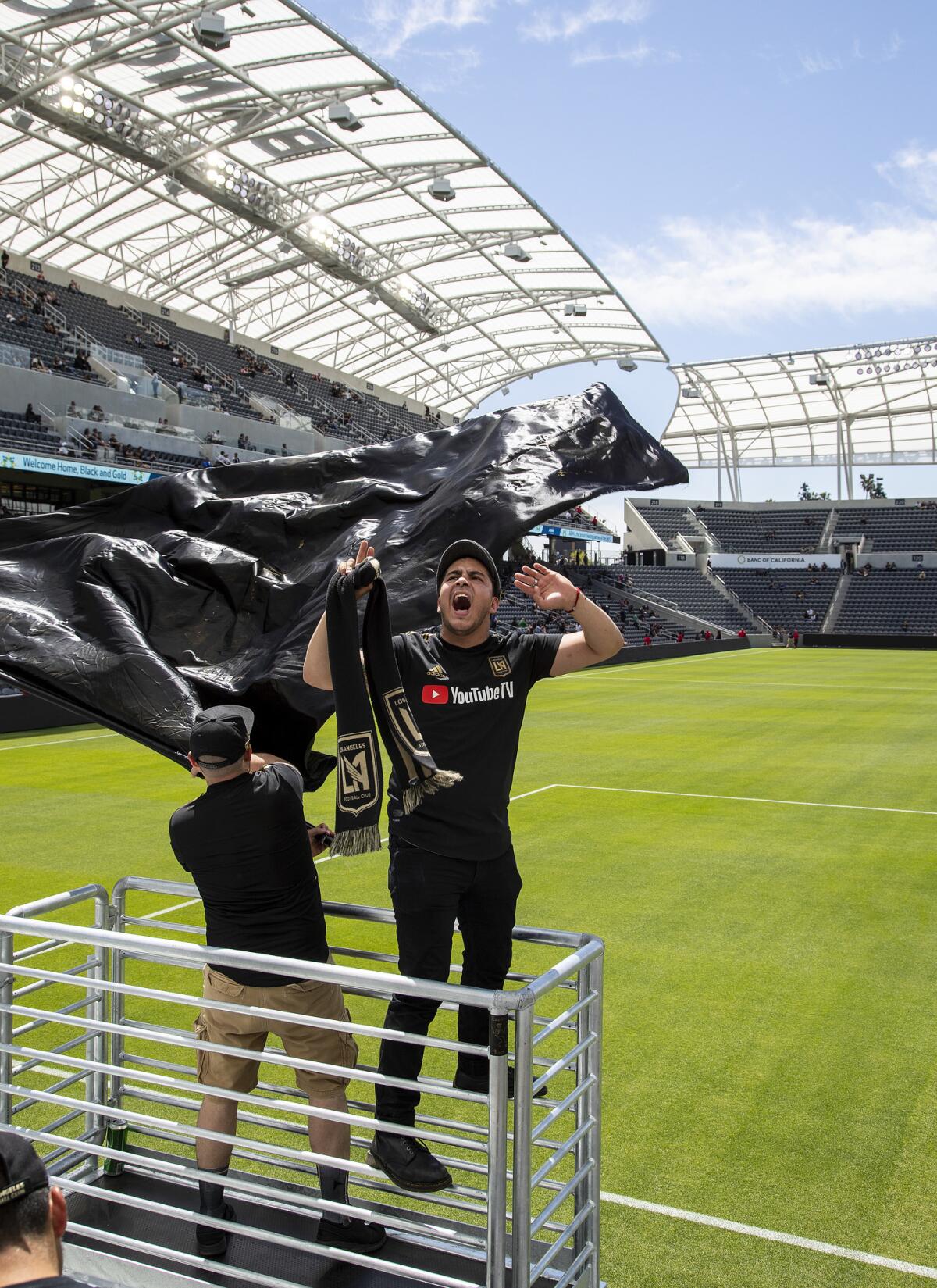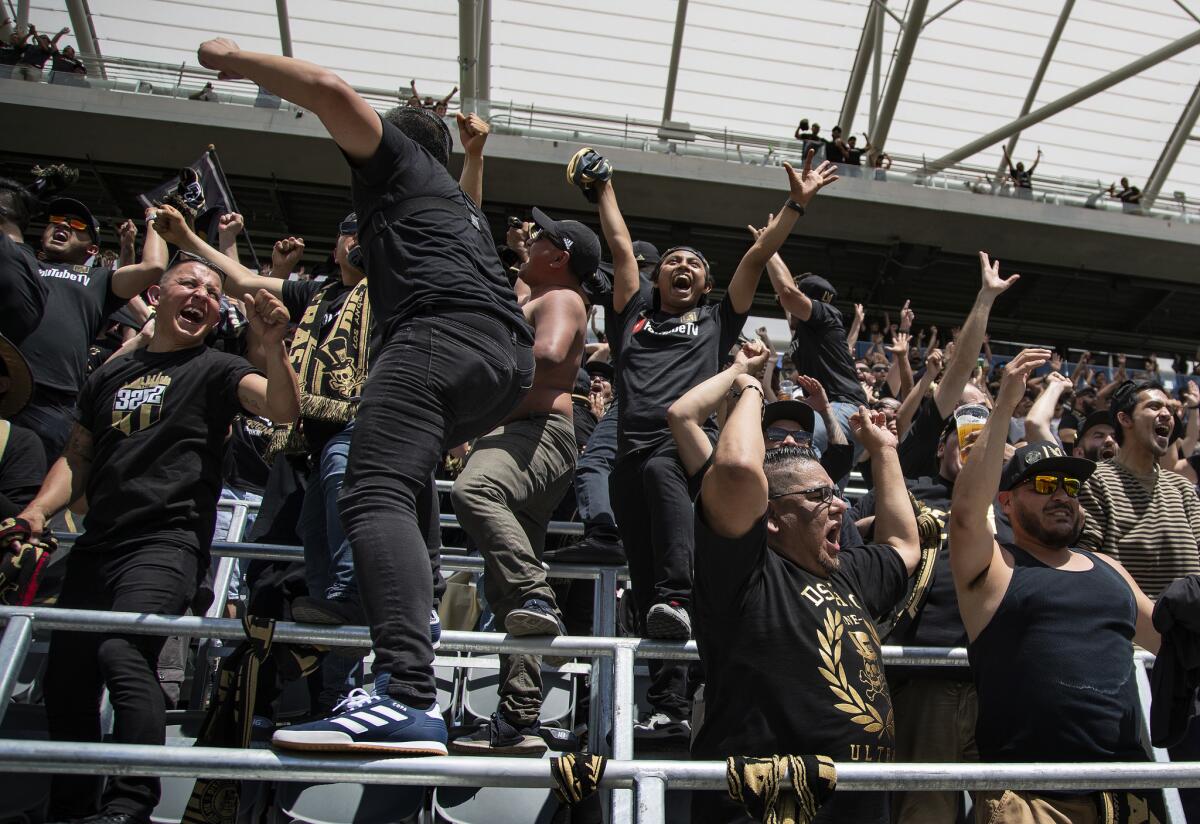LAFC supporters group has helped team establish its new identity

Soccer fandom has its own very strict code of conduct, one which ties a supporter to a team for life. But Josef Zacher thinks he’s found a loophole.
As a founding member of the Black Army 1850, the loud and raucous fan group that cheered on Chivas USA, Zacher’s pledge of allegiance was one he’d take to the grave.
But what if it’s the club that dies first?
“If you lose a wife, are you just supposed to no longer marry?” Zacher asked.
Freed by that technicality when Chivas USA was disbanded by MLS in 2014, he quickly transferred his backing to the Los Angeles Football Club, the expansion franchise that rose from the ashes of Zacher’s former team. And now, as president of the 3252, LAFC’s main supporter group, he finds himself tasked with establishing the fan culture for a team that will be playing the first home game in its history Sunday.
“Everything with this club is a clean slate,” said Zacher, sitting in the shade above the north goal line at Banc of California Stadium, LAFC’s new home in Exposition Park and a place that has played a huge role in defining what the team and its fans stand for.
“What happened over there doesn’t apply here,” he said of Chivas USA. “What happened over there doesn’t help here. The culture is completely different. The ownership is completely different.”
And the supporter groups are completely different too.
In most major U.S. sports, fans are drawn to teams by the franchise’s success, values or location, things that can — and sometimes do — change if the team is sold or the front office upended. In international soccer, however, it’s the supporter groups who often define and police their club’s culture.
So from the first day LAFC chose to let the fans lead the way.
The stadium’s great — all the flags and all the banners and all the scarves. But the culture endures.”
— Peter Guber, LAFC chairman

“When you build an organization, you build a culture,” said Peter Guber, the entertainment magnate who heads LAFC’s 30-member ownership group. “Culture is your business plan. Culture is the people. The stadium’s great — all the flags and all the banners and all the scarves.
“But the culture endures.”
As a result, one of LAFC’s first moves — before it had chosen a coach, signed a player or picked a site for its stadium — was to hire Rich Orosco as its executive vice president for brand and community and Patrick Aviles to direct supporter relations.
“I didn’t know if we were going to be able to build a united supporter group that was going to be together and impactful,” co-owner and team president Tom Penn said. “That’s been a one-on-one relationship for over three years led by Rich and Patrick and then by the supporter leaders.”
That relationship started with people like Zacher, Rafa Gomez, Julio Ramos, Jose Salcedo and Richard Escutia — self-identified LAFC supporters from the days when the team was no more than an idea — reaching out to the club. And they were encouraged when the club chose not to talk, but to listen.
“He asks us for advice. He’s asking our opinion. He wants to know what we want to do with our club,” Gomez said of Orosco. “This is a legacy that we’re creating. It’s not coming from a marketing team that’s telling you this and this.
“We have an active participation in the creation of this club.”
Supporters were consulted on the team colors, the look of the crest and the design of LAFC’s 22,000-seat stadium, built on land previously held by the Sports Arena. Defining the team’s culture has proved a bit more elusive, however, so LAFC flew nearly a dozen supporter-group leaders to Germany last February to meet with fans of Borussia Dortmund, the working-class Bundesliga team with deep values and an average attendance of more than 80,000 a game, best of any soccer club in the world.
“The biggest thing we learned is that for a club to truly be a club it needs to identify with the city and be a part of the fabric,” Zacher said. “If you can unite the city, you can’t go wrong. If you celebrate the culture of a city, the multiculturalism, you can’t go wrong.”

The supporters used the city as their template, embracing Los Angeles’ blue-collar pedigree, its patchwork quilt of languages, histories and customs.
Monty Stevenson, a member of the Expo Originals fan group, said LAFC supporters have purposely sought to distinguish themselves from fans of the Galaxy, the long-established and successful MLS club that plays in suburban Carson. A recent arrival from Australia, he said the process is similar to one the Western Sydney Wanderers followed when they joined that country’s top-tier league in 2012.
Based in Blacktown, among the most ethnically diverse areas of Sydney, the team wanted to be an alternative to Sydney FC, the older and more established club across town.
“There was a big contingent of Sydney that felt misrepresented by that team,” Stevenson said. “They’re all private-school kids and rich guys. Western Sydney, we’re very working class. There was a big divide. There was space for two teams.
“Here you’ve got Galaxy and you’ve got LAFC. There’s definitely room for two. So this reminds me of the building process for Western Sydney Wanderers, where they took the fans’ input with the stadium, what type of supporter culture we want to build, what kind of team style we want, what’s our vision for this club.”
Another vision that came into clearer focus with the help of Borussia Dortmund involved LAFC’s unique North End grandstand, whose 3,252 seats inspired the name supporters chose for the umbrella group encompassing the team’s five core fan groups. (The numbers also add up to 12, making the supporters the team’s 12th man.)
Supporters had long wanted the area to resemble a scaled-down version of Dortmund’s famed Yellow Wall terrace, an imposing and intimidating mass of 25,000 fans that stand, chant and cheer from long before kickoff until long after the final whistle.
“They were amazed by our stadium and by the Yellow Wall especially,” Daniel Stolpe, Borussia Dortmund’s deputy press spokesman, said of LAFC. “They always [said] how much of a positive influence our stadium was for them and the way we treat our fan culture. And we are honored by that.”
Copying the Yellow Wall proved problematic, though, because each ticket LAFC sold in its North Stand required a corresponding seat, a measure intended to prevent the team from squeezing a dangerous number of fans into a standing area. After researching the problem for two years, Gensler Sports, LAFC’s stadium architect, and Minneapolis-based SC Railing came up with a solution: seats that would fold up and lock behind a rail, creating a first-of-its-kind safe-standing area in a U.S. stadium.
Zacher said the supporters, like the team, will continue to evolve over time because culture is both organic and ever-changing. That makes LAFC’s supporter culture difficult to define today and impossible to plot into the future. The important thing is to follow it wherever it leads.
“If you take a cookie-cutter model, it’s going to look cookie-cutter and it’s going to feel really plastic. It’s not going to feel real,” he said. “So we have to develop our culture. It’s not going to be Day 1, everything is set, this is what we’re going to do. It can’t be.
“Things will happen in games that will define us. Things will happen outside of the stadium that will define us as supporters and LAFC fans. We just have to let them happen and latch on to it when it happens.”
Twitter: @kbaxter11




